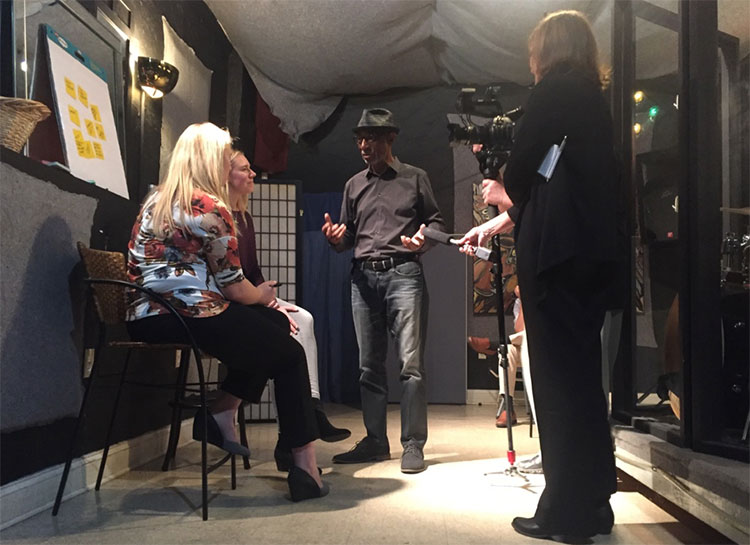Home » Design Thinking, Design Doing » Design Thinking, Design Doing: Checking in on Informances and Brainstorming
Design Thinking, Design Doing: Checking in on Informances and Brainstorming
Posted by anderc8 on Monday, October 23, 2017 in Design Thinking, Design Doing, News.

Rogers Hall, Professor, Department of Teaching and Learning
Written by Rogers Hall, Professor, Department of Teaching and Learning
Dave Owens and I are teaching approximately 40 undergraduates and graduate students in our University Course titled, Design Thinking, Design Doing. The official purpose of the course is to offer an intensive experience of human-centered design to Vanderbilt students as part of Design as an Immersive Vanderbilt Experience (DIVE), the university’s recently adopted Quality Enhancement Plan (QEP). The semi-official purpose of the course is to give Dave and I the opportunity to teach together and explore a variety of conceptual frameworks that take “design” as a central idea and human practice.
In a sense, we are all designers—when I prepare for a trip I re-use all sorts of strategies to pack as much of what I need (and no more) into the smallest possible bag that will allow me to get through TSA screening and onto a plane as quickly as possible. If you don’t follow this way of thinking, dump the contents of your wallet or purse on the kitchen table. Why that stuff and not other stuff? Our course explores how this everyday sense of design links up with design traditions in engineering, product development, urban planning, organizational leadership and research on human learning. Humans have always been designers (homo faber) and we mean to develop this explicitly among our students (and ourselves) in ways that encourage working on important societal problems.

Dave Owens, Professor for the Practice of Management and Innovation
We have been at it intensively for about eight weeks now, and our students have self-selected into 10 design teams. During the week of Oct. 16 we focused on two techniques: informances (Dishman, 2003) and brainstorming (Owens, 2012). Each technique invites intensive “design doing” by students alone and in teams.
Dishman, E. (2003). Designing for the new old: Asking, observing and performing future elders. Design research: Methods and perspectives, MIT Press, Cambridge, MA and London, England, 41-48.
Humans are inadequate proxies even for people who are exactly like us. We are impoverished proxies for people who differ from us in so many ways.
… To explore these unknowns, each of us adopted a character—what have been called “personas”—based upon representative combinations of actual people we had studied.
… using theatrical techniques—using live bodies interacting in real space and real contexts with props to produce a plausible story—as part of the design process itself (pp. 42-43)
Owens, D. A. (2012). Creative People must be stopped: 6 ways we kill Innovation (Without even trying). John Wiley & Sons.
Groups can be powerful agents of innovation. When members provide multiple perspectives, alternative problem-solving approaches, and production capability together, they can achieve things no individual can achieve on his or her own. To use groups to their highest potential for innovation doesn’t require much, except a safe environment, a desire to innovate, an environment for collaboration, and a simple process. (p. 92)
In this blog, I’ll share some of what is happening in and out of the classroom at the midpoint of the semester, using photographs I’ve taken while teaching and following the design teams.

Two members of The Quiet Ones design team enact “personas” in a quick (three minutes or less) informance of a critical need they have identified through observation and interviewing with their client (a VU faculty group developing a “lab” that can capture moments of innovation in design projects). To the left, whatever captures moments of innovation (the standing persona) launches an invasive effort to record everything a designer (seated persona) is doing. As the designer persona clams up, the capture persona goes for broke, opening notebooks and pushing a recording device further into the enacted workspace.
In the discussion that followed this informance, other student design teams raised questions about ethics, the reactivity of recording instruments and letting designers themselves “mark” moments of innovation or break through that index a continuous but passive recording “skin” in the design space. These ideas, we think, came out of the dilemma enacted in the informance, but they also advanced design thinking for The Quiet Ones. This is a central commitment of our course—Design Thinking and Design Doing are in a reflexive relation to each other.

This is a panoramic image of the class (a wonderful space in the Wond’ry) midway through a brainstorming exercise led by Dave. I’ve realized that Dave is really skilled at getting people to do things that are potentially embarrassing. I’m learning a lot as we go—like the proper way to use Post-it notes (e.g., it matters how you peel off each note and they stick persistently to paper but not to other surfaces). Each student has been writing privately and furiously with coarse tip markers (enforces brevity), and having arrayed ideas with one-sentence explanations, they are able to sort ideas into thematic clusters.
In the reports out on brainstorming from design teams, students were surprised as individuals that they had so many ideas (Dave challenged them to use up the entire Post-it stack). They were also surprised as teams that their ideas were so diverse. Even after working together for weeks with design clients, they each brought different perspectives to design problems and possible solutions.

The Sound Space design team interacts with their client, Mr. Lorenzo Washington (owner and curator of the Jefferson Street Sound recording studio and museum). Mr. Washington, a longtime resident of North Nashville and an advocate for the preservation of the history of music and social life along the Jefferson Street corridor, has plans to turn a working rehearsal space (the room they are standing in) into a gallery for the museum he is creating in his studio. Members of the design team (seated) ask questions about what the museum means to Mr. Washington and how he imagines visitors (e.g., children, parents, or historians) would use the space. This image captures part of the work our design teams are doing in the community, as they observe, conduct interviews and generate ideas they can prototype with clients in the weeks ahead. (A Vanderbilt video team is filming the exchange for reasons loosely related to the course.)
Later in the semester, design teams will begin sharing their ideas (and identified needs for expertise and guidance) with volunteer mentors from industry. Teams will develop prototypes that can be tested and refined with their clients. The course culminates with a presentation of designs to the class, mentors and clients. Graduate students (as an added assignment) will create design case studies that document and capture the reflexive relation between Design Thinking and Design Doing.
And Dave and I will learn a lot by hanging out together with all these remarkable young people. So there.
